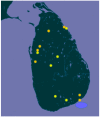Management and Utilization of Plant Genetic Resources for a Sustainable Agriculture
- PMID: 35956515
- PMCID: PMC9370719
- DOI: 10.3390/plants11152038
Management and Utilization of Plant Genetic Resources for a Sustainable Agriculture
Abstract
Despite the dramatic increase in food production thanks to the Green Revolution, hunger is increasing among human populations around the world, affecting one in nine people. The negative environmental and social consequences of industrial monocrop agriculture is becoming evident, particularly in the contexts of greenhouse gas emissions and the increased frequency and impact of zoonotic disease emergence, including the ongoing COVID-19 pandemic. Human activity has altered 70-75% of the ice-free Earth's surface, squeezing nature and wildlife into a corner. To prevent, halt, and reverse the degradation of ecosystems worldwide, the UN has launched a Decade of Ecosystem Restoration. In this context, this review describes the origin and diversity of cultivated species, the impact of modern agriculture and other human activities on plant genetic resources, and approaches to conserve and use them to increase food diversity and production with specific examples of the use of crop wild relatives for breeding climate-resilient cultivars that require less chemical and mechanical input. The need to better coordinate in situ conservation efforts with increased funding has been highlighted. We emphasise the need to strengthen the genebank infrastructure, enabling the use of modern biotechnological tools to help in genotyping and characterising accessions plus advanced ex situ conservation methods, identifying gaps in collections, developing core collections, and linking data with international databases. Crop and variety diversification and minimising tillage and other field practices through the development and introduction of herbaceous perennial crops is proposed as an alternative regenerative food system for higher carbon sequestration, sustaining economic benefits for growers, whilst also providing social and environmental benefits.
Keywords: centres of origin; climate change; conservation; crop domestication; crop wild relatives; cryopreservation; ecosystem restoration; genebank; germplasm; in vitro storage; plant breeding.
Conflict of interest statement
The authors declare no conflict of interest.
Figures








References
-
- FAO The Food and Agriculture Organisation. The State of Food Security and Nutrition in the World 2019. Safeguarding against Economic Slowdowns and Downturns. [(accessed on 2 February 2022)]. Available online: http://www.fao.org/3/ca5162en/ca5162en.pdf.
-
- UN United Nations 2030 Agenda for Sustainable Development—Sustainable Development Goals. Goal 2: Zero Hunger. [(accessed on 7 June 2022)]. Available online: https://www.un.org/sustainabledevelopment/hunger/
-
- FAO The State of Food Security and Nutrition in the World 2021: Transforming Food Systems for Food Security, Improved Nutrition and Affordable Healthy Diets for All. [(accessed on 25 May 2022)]. Available online: https://www.fao.org/3/cb4474en/online/cb4474en.html.
-
- IPBES . Global Assessment Report of the Intergovernmental Science-Policy Platform on Biodiversity and Ecosystem Services. The Intergovernmental Science-Policy Platform on Biodiversity and Ecosystem Services (IPBES)—IPBES Secretariat; Bonn, Germany: 2019. p. 1144.
-
- IPCC An IPCC Special Report on Climate Change, Desertification, Land Degradation, Sustainable Land Management, Food Security, and Greenhouse Gas Fluxes in Terrestrial Ecosystems. [(accessed on 5 May 2022)]. Available online: https://www.ipcc.ch/site/assets/uploads/2019/11/Headline-statements_Fina....
Publication types
LinkOut - more resources
Full Text Sources

